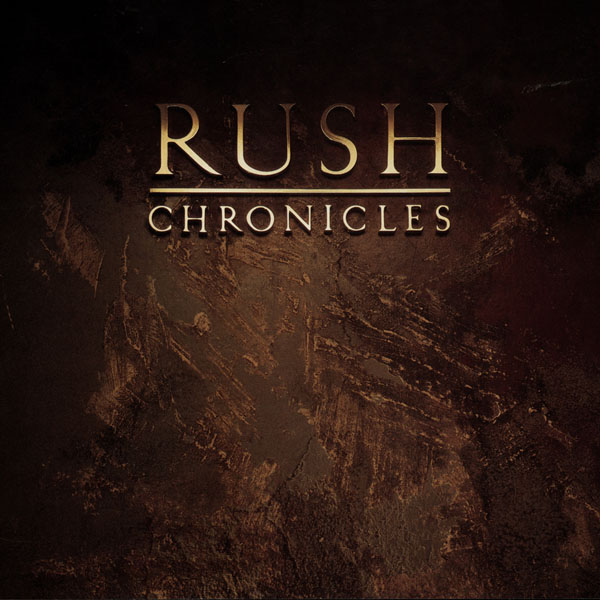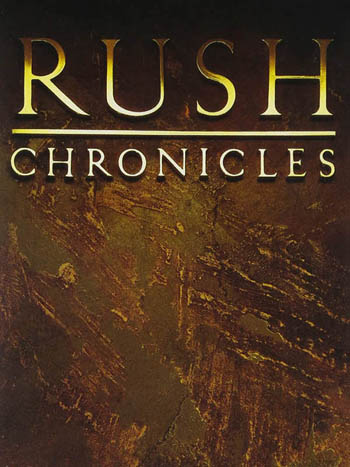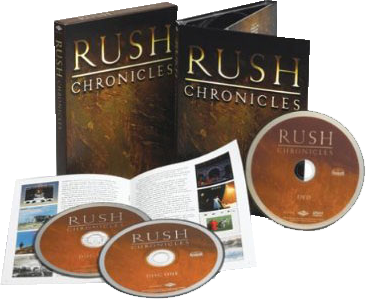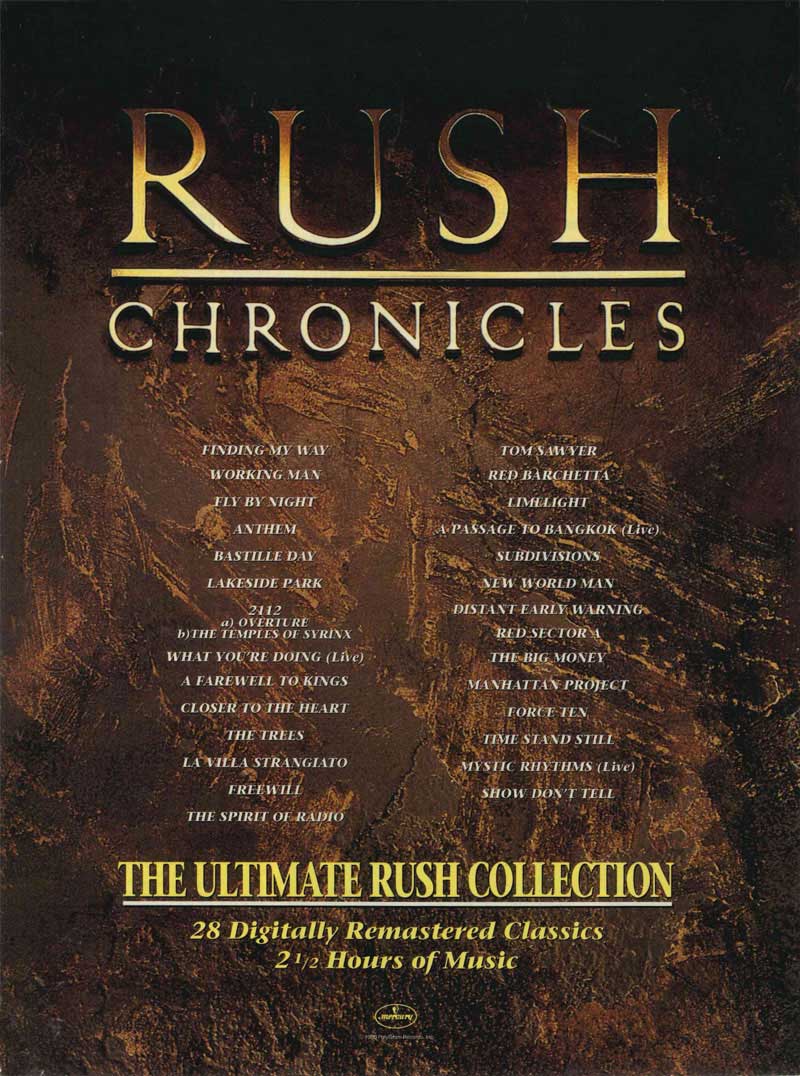
Audio Collection Tracklist
CD One
Finding My Way (5:08)
Working Man (7:12)
Fly By Night (3:21)
Anthem (4:24)
Bastille Day (4:39)
Lakeside Park (4:10)
2112 Overture/Temples of Syrinx (6:48)
What You're Doing (live) (5:41)
A Farewell To Kings (5:53)
Closer To The Heart (2:54)
The Trees (4:41)
La Villa Strangiato (9.34)
Freewill (5:23)
The Spirit Of Radio (4:57)
CD Two
Tom Sawyer (4:37)
Red Barchetta (6:10)
Limelight (4:22)
A Passage To Bangkok (live) (3:47)
Subdivisions (5:35)
New World Man (3:42)
Distant Early Warning (5:59)
Red Sector A (5:13)
The Big Money (5:35)
Manhattan Project (5:07)
Force Ten (4:34)
Time Stand Still (5:10)
Mystic Rhythms (live) (5:42)
Show Don't Tell (5:01)

Video Collection Tracklist
Closer To The Heart [live]
The Trees [live]
Limelight [studio]
Tom Sawyer [dvd: Le Studio version; vhs/laserdisc: live ESL version]
Red Barchetta [live ESL version]
Subdivisions
Distant Early Warning
Red Sector A [live p/g tour version]
The Big Money [edit]
Mystic Rhythms
Time Stand Still
Lock And Key
Afterimage*
The Enemy Within*
Click on the "Chronicles" icon which appears in the upper left corner a few seconds after the main menu appears and the menu will reload to include Afterimage & The Enemy Within
Chronicles Linernotes
By John Swenson
At the end of the 1960s much of rock and roll as we now know it was still largely unchartered territory. The dominant styles were not yet institutionalized; in many cases the original practitioners were still hammering out the final details of what would become standard rock formats. For Canadian rockers the landscape was even more uncharted. Once past the Guess Who and Gordon Lightfoot, in fact, you were pretty much on your own. That's exactly where the young guitarist Alex Lifeson and bassist/vocalist Geddy Lee found themselves as they rehearsed in Toronto basements while the '60s were fast becoming history.
These two players would eventually go on to form Rush and become the most accomplished Canadian rockers in history. But the history of Rush is a success story won against seemingly insurmountable odds.
The young Lifeson and Lee cut their teeth on British blues from the Yardbirds to Cream and prototype heavy metal from the Who to Led Zeppelin.
"We came from pretty much the same neighborhood," Lee said. "We met in the eighth grade. Alex used to borrow my amplifier all the time. We played in coffee shops for chips and gravy. I worked in my mother's hardware store for a while. Alex worked in a gas station."
"We were playing the English blues-John Mayall, Cream. Alex would pretend he was Eric Clapton, I would pretend I was Jack Bruce, and we'd play 'Spoonful' for twenty minutes."
Lee and Lifeson formed a power trio and became Canada's first significant heavy metal band. Rush built up a reputation as one of the best live bands in the Toronto area, and became a bona fide underground sensation.
But the record industry simply didn't take the music scene in Canada seriously back then. Plenty of Canadian musical luminaries were forced to migrate in order to record-such homegrown talent as Neil Young, Joni Mitchell and Robbie Robertson went south of the border in order to be heard.
Rush, built around Lee's unique vocal style and Lifeson's rhythm-lead techniques, released a self-produced album, Rush, on the independent Moon Records label. The album is a crudely effective representation of the band's live sound at the time. "Finding My Way" shows the band kicking away in Zeppelinesque mode. The first track on the first album, this is the recording the band chose to give first impressions, making it the appropriate opener for Chronicles.
"Working Man" looks forward to what Rush would become, a fast-fretting power trio carried by Lifeson's lightning-fast guitar leads. The jam-session format of this seven minute workout showed just how exciting the band could be live.
Rush was selling out on the basis of word-of-mouth in record stores, and sold so well as an import in the midwest that Chicago-based Mercury Records took notice and signed Rush to a long-term contract. Drummer John Rutsey left the band at this time to pursue other interests.
The bands next album on Mercury, Fly By Night, featured an embellishment on the Zeppelin-inspired style, but the band's sound was much better structured due to the addition of drummer Neil Peart, who brought the precision and ensemble sense of a percussionist schooled in the art-rock forms of Pink Floyd and King Crimson.
Fly By Night offers a hint of the kind of melodic song structures that the band would eventually evolve, while "Anthem" polished the sculpted, hard rock sound of the first album to a glistening sheen.
On the third album, Caress of Steel, songs like "Bastille Day" and "Lakeside Park" showed the band developing more varied and complex song structures and a penchant for unusual songwriting themes.
Peart exerted a strong influence on Rush, and not just musically. His science fiction-inspired imagination provided the impetus for a series of concept albums that added a new twist to the band's identity. Their breakthrough album, 2112, developed an intriguing science fiction tale of a future hero who leads a revolution through music.
The album also marked a musical evolution for the group, away from the slabs of sound that dominated the heavy metal approach to the nuanced, trance music patterns and dramatic stop-time arrangements that would become a Rush trademark.
Rush had come of age, as the tremendously popular followups, the live All The World's A Stage and two more conceptual albums, A Farewell to Kings and Hemispheres, proved. 2112, Farewell and Hemispheres worked together thematically as a post-apocalypse trilogy, and the band's stage shows revolved around these stories, backed up by the elaborate visuals on a giant screen behind the stage. The melodic "Closer to the Heart" became an emotional high point live, while "The Trees" and "La Villa Strangiato" showcased Lifeson's increasingly virtuosic guitar playing.
It wasn't until the 1980 album Permanent Waves, though, that Rush made the most dramatic transformation. Having gone through heavy metal and art rock, the band emerged as an arena and FM radio-oriented band, spinning catchy yet thoughtful tunes like "Freewill" and "The Spirit of the Radio". Lee, always a stupendous bassist, suddenly took center stage with his extraordinary synthesizer work.
"It was time to stop the concept stories," Lee said. "What you have to say ends up being very nebulous, because you're concerned with the big story. You try to make the story right, you try to evoke the right moods, and invariably sixteen different people come up to you and tell you sixteen different things about what you're trying to say. That's fine, but for us it was time to come out of the fog for a while and put down something concrete."
What they put down was the foundation for one of the most durable arena rock presentations of the '80s. Moving Pictures picked up where Permanent Waves left off and went on to become the band's most influential album on the strength of such compelling songs as "Tom Sawyer", "Red Barchetta" and "Limelight.
During a break in the band's recording schedule, Rush released the live album Exit...Stage Left, a document of the increasingly popular Rush tours. The title, taken from the "Huckleberry Hound" cartoon, revealed a little-known side of the band, its sense of humor. Over the years, Rush had used bits from the SCTV comedy troupe and the Three Stooges in their act, and Lee sings on "Take Off", a track from a comedy album made by two SCTV characters, Bob and Doug McKenzie.
Unlike many successful bands, once Rush reached the pinnacle they refused to sit on their laurels but chose to pursue an intensive touring and recording schedule.
Few bands have managed to mirror the stylistic changes rock has undergone in the '70s and '80s, but Rush changed its sound album to album, evolving along with the innovations of the time. Though the band's complex sound defies anyone categorization, the influence of technological and stylistic developments characteristic of the early '80s are evident on "Subdivisions" and "New World Man" from Signals, and "Red Sector A" and "Distant Early Warning" from Grace Under Pressure.
"The most exciting aspect of being in this band is the compositional challenge," Lee explained. "I think the writing stage is the most rewarding; everything else revolves around that. I don't think that was true ten years ago; it was playing then. But now I look at myself as more of a musician in the compositional sense than the playing sense. That's what makes it worthwhile."
Rush songs have often centered on political and environmental concerns over the years. Power Windows features two of the bands most compelling treatments of these themes, "The Big Money" and "Manhattan Project".
The band's compositional evolution continued on Hold Your Fire, which includes the beautiful "Time Stand Still" and the dynamic "Force Ten". The space-age overtones of the album's themes correspond to its increasingly complex song structures. The band that started out as a heavy metal contender evolved into a musical presentation closer to the jazz theories of fusion.
The band sees Hold Your Fire as the end of a phase of its development. "To me Hold Your Fire is an arrival record," said Lee. "We climbed up a hill and now we've gotten to the top and we have to decide where we go from here." As usual, a live album was the next step as Rush considered its future. A Show of Hands, the band's third live set, was the perfect summation of where Rush was as the band prepared for its next phase.
After a creative hiatus, Rush emerged with a new album, Presto, and a fresh attitude. "Show Don't Tell" charts the new direction, articulating a healthy skepticism toward authority couched in a direct, anthemic style that makes the song a rallying cry. Twenty years after the band's inception, Rush is still finding new modes of expression.
GEDDY LEE-bass guitar, bass pedals, synthesizers, vocals
ALEX LIFESON-electric and acoustic guitars, synthesizers
NEIL PEART-drums, percussion, electronic percussion
John Rutsey-drums on "Finding My Way", "Working Man"
Additional vocals on "Time Stand Still" by Aimee Mann, courtesy of Epic
Records
Compiled by Bill Levenson
Essay by John Swenson
Mastered by Bob Ludwig, Masterdisk, NYC
Digitally compiled by Denis Drake, PolyGram Studios and Bob Ludwig, Masterdisk,
NYC
Art direction by Hugh Syme
Photography by John Scarpati and Andrew MacNaughtan
Management by Ray Danniels, SRO Management Inc., Toronto
© 1990 PolyGram Records © 1990 Anthem Entertainment
"Show Don't Tell" © 1989 Atlantic Records © 1989 Anthem Entertainment
Notes
- Album Release: September 4, 1990. Highest Billboard Chart Position: 51. Certified Gold & Platinum: April 13, 1992, 2x Platinum: November 21, 1995
- Video Release: October 23, 1990. Certified Platinum: July 30, 2002. Runtime 63 minutes.
- The Chronicles audio collection was released on CD, Vinyl and Cassette on September 4th, 1990, and is now officially "out of print" in all three formats. The Chronicles Video Collection was released on VHS October 23, 1990, LaserDisc May 19, 1992 and as a subsequent no-frills (not even a linernotes insert) DVD release September 25, 2001. The ultimate Chronicles release came in 2005, when the "Sound + Vision" Edition combined both the DVD and the 2CD collection along with an improved linernotes booklet in a collectable digipack slip case.
- The album was Rush's first North American compilation of their first 12 studio albums (their Mercury years 1974-1987), compiled before the Mercury catalog was digitally remastered.
- "What You're Doing" was originally dropped due to space limitations from the original CD release of All the World's A Stage, while "A Passage To Bangkok" was similarly dropped from Exit...Stage Left; both tracks first appeared on CD on Chronicles.
- With the inclusion of "Afterimage" and "The Enemy Within" as Easter Eggs in the Video Collection DVD, the only videos not included which were previously found on the Through the Camera Eye video compilation are "Countdown", "Vital Signs", and "The Body Electric".
- The first 100,000 copies produced of Spirit Of Radio: Greatest Hits (2003), included a bonus DVD sampler of the Chronicles video collection, containing videos of "Tom Sawyer", "Closer to the Heart", "Subdivisions", "The Big Money" and "Mystic Rhythms", plus lyrics to all the songs on the album.

In Their Own Words
"It's been a bit of a fight with [PolyGram]. So far we have had no control over it, they wanted to put in stuff that just doesn't belong there. Things that Geddy had done a few years ago. But now we're working something out with Atlantic's cooperation, they've been great about it. We at least want to be able to look after the packaging and try to make it as good as all our other stuff has been in the past." - Alex Lifeson, Kerrang! #266, November 25, 1989
"I thought they did a really shoddy job in terms of the song order...purely chronological, and the artwork was lame." - Neil Peart, Rollingstone.com, June 5, 1997
"The video [for "Distant Early Warning"] featured Geddy's son Julian. 'I don't remember too much, except sitting on this rocket thing as if I was riding it for a really long time,' Julian recalled. 'Neil let me play his drums, but I had to be REALLY careful!'" - Chemistry
